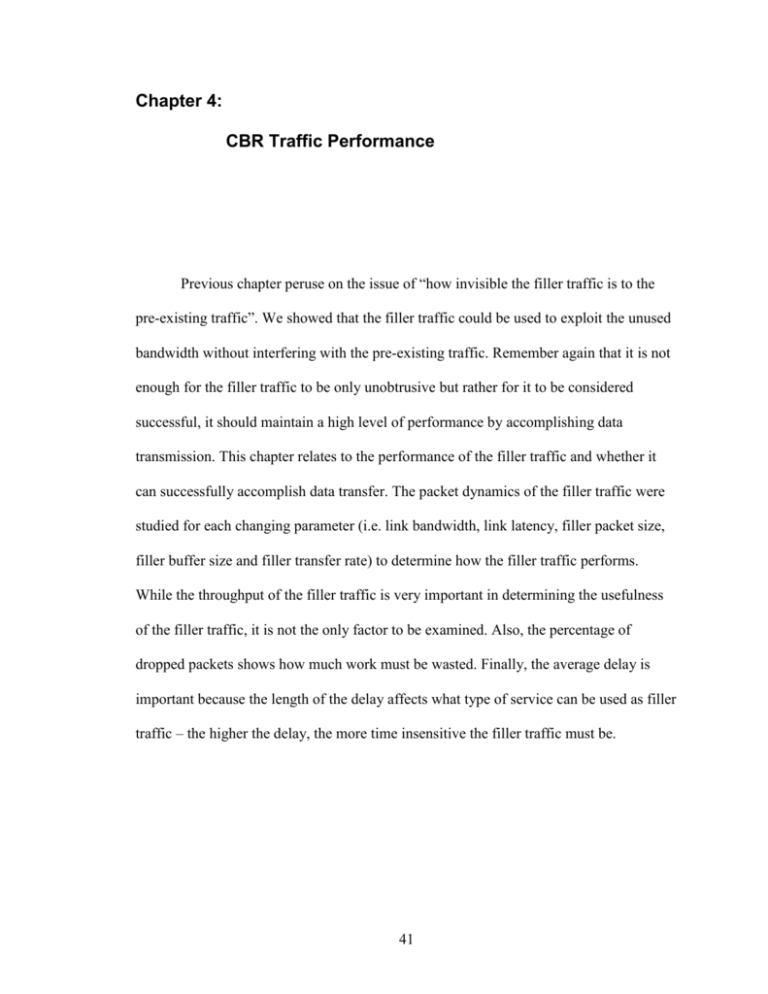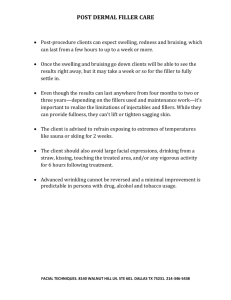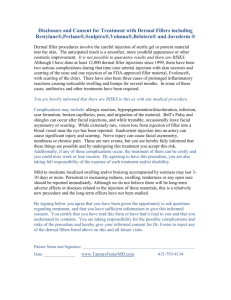CBR Traffic Performance
advertisement

Chapter 4: CBR Traffic Performance Previous chapter peruse on the issue of “how invisible the filler traffic is to the pre-existing traffic”. We showed that the filler traffic could be used to exploit the unused bandwidth without interfering with the pre-existing traffic. Remember again that it is not enough for the filler traffic to be only unobtrusive but rather for it to be considered successful, it should maintain a high level of performance by accomplishing data transmission. This chapter relates to the performance of the filler traffic and whether it can successfully accomplish data transfer. The packet dynamics of the filler traffic were studied for each changing parameter (i.e. link bandwidth, link latency, filler packet size, filler buffer size and filler transfer rate) to determine how the filler traffic performs. While the throughput of the filler traffic is very important in determining the usefulness of the filler traffic, it is not the only factor to be examined. Also, the percentage of dropped packets shows how much work must be wasted. Finally, the average delay is important because the length of the delay affects what type of service can be used as filler traffic – the higher the delay, the more time insensitive the filler traffic must be. 41 42 4.1.Link bandwidth While varying the link bandwidth, the filler traffic performs very similar to the pre-existing traffic, as shown in figure 4.1. The average delay of the filler traffic decreases dramatically as the link bandwidth increase. In the worst case (i.e. when the bandwidth was only 2 Mbps), the average delay of the filler traffic was only less than 0.15 seconds in the experiments involving trace 1, was less than 0.2 seconds in experiments involving trace 2 and was less than 0.25 seconds in experiments involving trace 3. However, when the bandwidth was 10 Mbps, the average delay of the filler traffic was just 5% higher than the actual link latency, that is 20 milliseconds. Compared to the average delay of the pre-existing traffic, the average delay of the filler traffic was approximately five times the average delay of the pre-existing traffic on the experiments with no filler present at the same link bandwidth. 0.3 Trace 1 Average Delay (s) 0.25 Trace 2 0.2 Trace 3 0.15 0.1 0.05 0 0 2 4 6 8 10 12 14 Bandwidth (Mbps) Figure 4.1: Average delay of the filler traffic as a function of the link bandwidth 16 43 When the bandwidth was 10 Mbps, which was the real capacity of the link connecting Harvard University to the Internet, the average delay of the filler traffic was higher than the average delay of the pre-existing traffic by only less than 2 milliseconds. 80 . Dropped packets % 100 Trace 1 Trace 2 60 Trace 3 40 20 0 0 2 4 6 8 10 12 14 16 Bandwidth (Mbps) Figure 4.2: Filler drop rate as a function of the link bandwidth Figure 4.2 shows the percentage of the filler dropped packets as the link bandwidth varies. The percentage of the dropped packets decreases linearly as the link bandwidth increase until the link bandwidth was greater than the CBR rate. As the figure shows, the drop rate on the filler traffic was very high in the experiments with low bandwidth. This is expected because of two reasons. First, the filler packets are the low priority packets and hence they will get dropped before any higher priority packets (i.e. 44 the pre-existing packets). Second, CBR traffic does not adapt itself to the state of the network; it just keeps sending packets at a constant fixed rate regardless the line capacity or routers congestion. However, when the link bandwidth was greater than the CBR rate (in our experiments that is 6 Mbps) the filler drop rate remains at reasonable levels. For a bandwidth of 10 Mbps, the filler drop rate was never higher than 0.1%. In our experiments the average throughput of the pre-existing traffic was about 1.34 Mbps, and when setting the line capacity to 8 Mbps (greater than 7.34 Mbps of pre-existing and filler), the drop rate was never higher than 3%. Adam Feldman in [16] shows that if TCP/FTP was used as the filler traffic, the dropped packets are very low, never surpassing the percentage of dropped pre-existing packets by more than 0.2%. We conclude that for the CBR filler traffic to be considered successful in accomplishing data transfer, the rate of the CBR should never be higher than the line capacity. To be more precise, the rate should be set to the amount of bandwidth left after subtracting the average throughput of the pre-existing traffic from the link bandwidth (i.e. the available bandwidth) As the bandwidth increases, the throughput of the filler traffic (i.e. the amount of filler bytes that crosses the center link in a time unit) increase at a linear rate with roughly unit slop until the bandwidth of the center link was the same as the sum of both the rate of injecting the CBR filler traffic and the average throughput of the pre-existing traffic. Then the throughput of the filler traffic remains at a constant level after the bandwidth was greater than the CBR rate, as shown in figure 4.3. The reason behind this is that the CBR filler injects bytes to the network at a constant and fixed rate. Hence, after the link 45 capacity is enough to accommodate the sum of both the filler and the pre-existing traffic, there will be no noticeable increase on the throughput regardless the increase on the bandwidth because the nodes are working on there full capacity. With FTP/TCP filler traffic, however, the throughput continues to increase at a linear rate because there is no fixed bound on the rate of sending the filler packets but rather the rate is controlled by the TCP congestion control [16]. Experiments without filler traffic were conducted as bases for comparison. These experiments show that the link utilization when there was no filler used was less than 20%. This ratio was increased by the introduction of the filler traffic to be approximately 95% utilization, of both the filler traffic and the pre-existing traffic, when the center link Average Throughput (KB / Sec) bandwidth was 10 Mbps and the CBR rate was 8 Mbps. 800 700 600 500 Trace 1 400 Trace 2 300 Trace 3 200 100 0 0 2 4 6 8 10 12 Bandwidth (Mbps) Figure 4.3: Filler throughput as a function of the link bandwidth 14 16 46 4.2.CBR Rate As figure 4.4 shows, CBR rate has little effect on the average delay of the filler traffic when the CBR rate is less than the available bandwidth of the center link. The average delay of the filler traffic in the experiments involving trace 3 was less than 25 milliseconds when the link bandwidth was 8 Mbps that is less than 20% increase from the average delay of the pre-existing traffic in the experiments that involves no filler on the same link bandwidth. However, when the CBR rate approaches the link capacity the average delay of the filler traffic increase substantially. With CBR rate of 10 Mbps, the average delay of the filler traffic was about 67% higher than the average delay of the preexisting traffic. As a conclusion, we recommend to use a filler rate that is not higher than the amount of available bandwidth after subtracting the average throughput of the preexisting traffic. 0.036 Average Delay (s) 0.034 0.032 Trace 1 Trace 2 0.03 Trace 3 0.028 0.026 0.024 0.022 0.02 0 2 4 6 8 10 CBR Rate (Mbps) Figure 4.4: Average delay of the filler traffic as a function of the CBR rate 12 47 18 14 Trace 1 12 Trace 2 10 Trace 3 . Dropped Packets % 16 8 6 4 2 0 0 2 4 6 8 10 12 CBR Rate (Mbps) Figure 4.5: Filler drop rate as a function of the CBR Rate Figure 4.5 show that the percentage of dropped packets increases exponentially as the CBR rate increases above the amount of available bandwidth after subtracting the average throughput of pre-existing traffic. With CBR rate of 10 Mbps, the percentage of dropped packets was less than 15%. However, for lower CBR rates (less than 8 Mbps), the dropped packets of the filler traffic remains at very low levels, less than 2%. Its worth to mention that only the filler packets were dropped which are the low priority packets. In the previous chapter we showed that there was no dropped pre-existing packets. As the CBR rate increase, the throughput of the filler traffic increased, at a linear rate with roughly a unit slop as shown in figure 4.6. The effect of the CBR rate on the filler throughput is less visible with higher CBR rates. To summarize, the CBR rate should be set to not more than the available bandwidth in order to maintain a low drop rate and a reasonable filler delay. Average Throughput (KB / Sec) 48 1200 1000 800 600 Trace 1 400 Trace 2 Trace 3 200 0 0 2 4 6 8 10 12 CBR Rate (Mbps) Figure 4.6: Filler throughput as a function of the CBR rate 4.3.Filler Buffer The size of the filler buffer affects the average delay of the filler traffic, as there is a little increase on the delay as the buffer size increase. Figure 4.7, however, shows that this increase is very small (less than 0.8 milliseconds). This increase on the average delay of the filler traffic is due to the fact that packets can stay longer in longer queues. Also, as the filler buffer size increases, the percentage of filler dropped packets decrease, as shown in figure 4.8. This tradeoff between the percentage of dropped packets and the average delay of the filler traffic is expected and natural; as the buffer grows, packets can stay longer, and hence, the increase on the average delay. Meanwhile, larger buffer can accommodate more packets, and hence, reduces the percentage of the dropped packets. 49 0.022 Trace 1 Average Delay (s) 0.0218 Trace 2 0.0216 Trace 3 0.0214 0.0212 0.021 0.0208 0.0206 0 5 10 15 20 25 30 35 Filler Buffer (KB) Figure 4.7: Average delay of the filler traffic as a function of the filler buffer size 2.5 Trace 2 . Dropped packets % Trace1 2 Trace 3 1.5 1 0.5 0 0 5 10 15 20 25 30 Filler Buffer (KB) Figure 4.8: Filler drop rate as a function of the filler buffer size 35 50 4.4.CBR Packet Size Figure 4.9 shows how the average delay of the filler packets increased slightly as the packet size increases. There was a 3 milliseconds (or 14%) increase in the average delay for the filler packets of size 4500 Bytes than the filler packets of size 576 Bytes. This small increase on the average delay of the larger filler packets is expected due to the difference on the transmission times of the packets. Packets of size 576 Bytes will take less than 1 millisecond to transmit, while the 4500 Bytes packets will take about 4 milliseconds to transmit. Hence, the filler packets were not delayed in addition to the increased transmission time due to larger packets. 0.0245 Average Delay (s) 0.024 0.0235 0.023 0.0225 Trace 1 0.022 Trace 2 0.0215 Trace 3 0.021 0.0205 0 1000 2000 3000 4000 Packet Size (Bytes) Figure 4.9: Average delay of the filler traffic as a function of the CBR packet size 5000 51 The drop rate of the filler traffic increased from about 0.2% for the 576 Bytes packets to about 0.7% for the 4500 Bytes packets. That is approximately a 0.5% increase on the dropped filler packets, as shown in figure 4.10. Although the drop rate increased as packet size was varied from 576 Bytes to 4500 Bytes, it never exceeded 0.4% in experiments involving trace 1, 0.2% in experiments involving trace 2 and 0.7% in experiments involving trace 3. Changing the packet size affects the throughput of the filler traffic, as figure 4.11 illustrates. As the CBR packet size increases, the throughput of the filler traffic decreases. However, this increase is very small. The filler throughput increases by no more than 0.5% as packet size changed from 576 Bytes to 4500 Bytes. 0.8 Trace 1 Trace 2 0.6 . Dropped Packets % 0.7 Trace 3 0.5 0.4 0.3 0.2 0.1 0 0 1000 2000 3000 4000 Packet Size (Bytes) Figure 4.10: Filler drop rate as a function of the CBR packet size 5000 Average Throughput (KB / Sec) 52 751 750 749 748 747 Trace 1 746 Trace 2 745 Trace 3 744 0 1000 2000 3000 4000 5000 Packet Size (Bytes) Figure 4.11: Filler throughput as a function of the CBR packet size 4.5.Link Latency As the link latency increases, the average delay of the filler packets increased linearly at approximately unit slop, as shown in figure 4.12. Recall that the average delay is a measure of the time a packet waits in the buffer before being sent, plus the amount of time it takes to transmit the packet across the center link. Hence, as mentioned in section 3.5, because the increase on the latency is linear with unit slope, the average delay is only due to the transmission delay and there is no noticeable queuing delay added to the filler traffic. 53 Exact delay figures showed that the average queuing delay for the filler packets, as we changed the link latency, was never higher than 2 milliseconds, which is on the same magnitude as the queuing delay of the pre-existing packets. This is a good supporting evidence that even low priority packets (i.e. filler packets) need not to suffer from long queuing delay especially when link and filler parameters were set appropriately. Filler drop rate and filler throughput remains at constant levels while the link latency was varied between the 3 milliseconds and 250 milliseconds. Figure 4.13 shows the percentage of dropped packets as the latency increases. Also figure 4.14 shows the filler throughput as the latency increased. 0.3 Average Delay (s) 0.25 0.2 0.15 Trace 1 Trace 2 0.1 Trace 3 0.05 0 0 50 100 150 200 250 Link Latency (ms) Figure 4.12: Average delay of the filler traffic as a function of the link latency 300 54 0.2 . Dropped packets % 0.25 0.15 Trace 1 Trace 2 Trace 3 0.1 0.05 0 0 50 100 150 200 250 300 Link Latency (ms) Average Throughput (KB / Sec) Figure 4.13: Filler drop rate as a function of the link latency 755 Trace 1 753 Trace 2 Trace 3 751 749 747 745 0 50 100 150 200 Link Latency (ms) Figure 4.14: Filler throughput as a function of the link latency 250 300 55 4.6.Discussion and conclusions We have investigated the packet dynamics of the filler traffic to determine if it can accomplish data transfer. Results show that, in many cases, the filler traffic performed nearly as well as the pre-existing traffic. Specifically, the average throughput of the filler traffic increases as the link bandwidth increases. However, because CBR injects packets at fixed rate, the increase on the filler throughput is limited by CBR rate. For bandwidths that are higher than the sum of both the pre-existing and filler traffic, the drop rate of the filler traffic was never higher than 3%. Also as the CBR rate increase, the percentage of filler dropped packet increase. Changing the link latency has no effect on the percentage of dropped packets. Average delay of the filler traffic was affected by the link bandwidth. As the bandwidth increases, the average delay decreases. For a bandwidth of 10 Mbps (the base case) the average delay of the filler traffic was higher than the average delay of the preexisting traffic by only 2 milliseconds. Increasing the link latency increases the average delay linearly with unit slope. Hence, no significant queuing delay was encountered. There is a natural tradeoff between the delay and the dropped packets as the filler buffer size changed. This is because longer queues can accommodate more packets (i.e. less drop rate) but then packets can wait longer (i.e. higher delay). To summarize, results shows that the filler traffic can accomplish data transmission, in many cases, as good as the pre-existing traffic. Along with the previous one, this chapter concludes that filler traffic can be kept unobtrusive from the pre-existing traffic while maintaining high performance in transferring data.




